

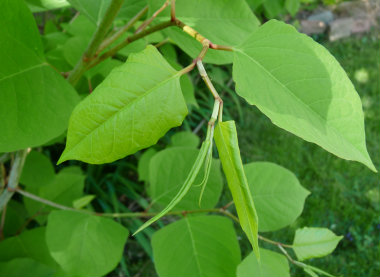

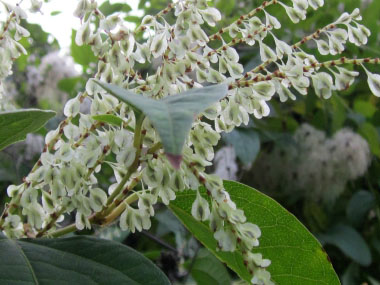
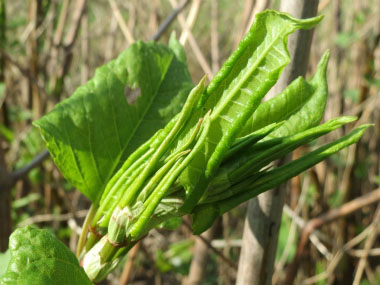
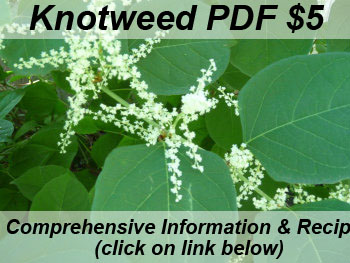
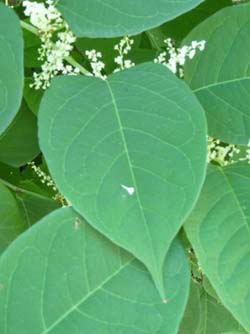
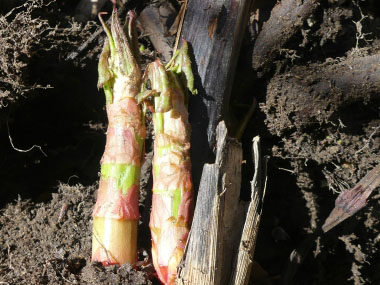
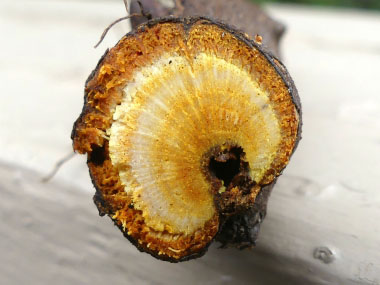
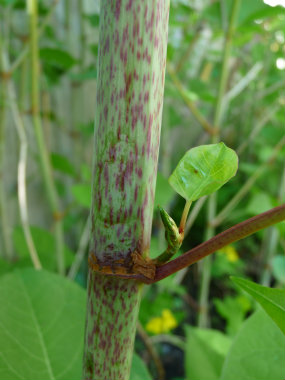
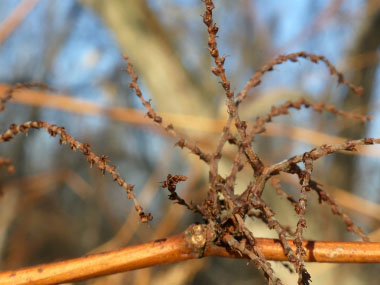
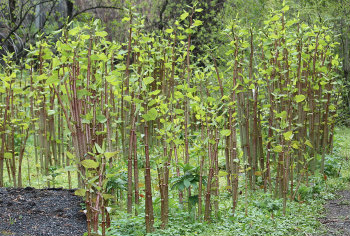
For comprehensive information (e.g. nutrition, health benefits, recipes, history, harvesting tips, etc.) please check out our Japanese Knotweed PDF magazine.
Japanese knotweed is in the Buckwheat family, and is generally not liked in western nations because it can grow up to one metre per month, its roots travel over three metres deep, and they spread up to 7 metres in every direction. It grows through concrete, asphalt, dams, and buildings. Japanese Knotweed is known as Polygonum cuspidatum in North America, in Europe it is known as Fallopia japonica. It is a very tolerant plant and survives in a wide range of soil types. Its rhizomes can survive temperatures of −35 °C (−31 °F).
Distinguishing Features
In the early spring, Japanese knotweed looks like nondescript fat, green, red-flecked stalks poking up from the ground. Although the young leaves are hard to identify, the big clue to the plant's identity are the dead stalks from the year before. They resemble bamboo, are hollow, lightweight and have wooden-like stems. By early summer mature stems are hollow with purple speckles and are very tall. The leaf growth alternates on each side of the stem creating an obvious zigzag pattern.
Flowers
The white flowers are very small but numerous and they form showy, greenish-white branching panicles from the axils of upper leaves. These ‘spike’ of flowers are about 10cm in length. Japanese knotweed usually flowers from July to September.
 Fields
of Nutrition has medicinal benefits and vitamin/mineral content of Japanese Knotweed.
Fields
of Nutrition has medicinal benefits and vitamin/mineral content of Japanese Knotweed.
Leaves
Japanese knotweed leaves are alternate, broadly ovate, square-cut or slightly angled at the base, abruptly pointed at the tip with the tip often stretched out, colourless and are hairless.
Height
This edible plant can grow up to one metre every month and can reach heights of up to four metres.
Habitat
Japanese knotweed can tolerate a variety of adverse conditions, including dense shady areas, high temperatures, high salinity soils and drought. Knotweed is commonly found near water sources, in low-lying areas, waste areas, and around old home sites. Japanese knotweed is native to Japan and grows in Canada, U.S., England, some parts of Europe, Australia, New Zealand, China, Korea, and eastern Asia.
Edible Parts
The best edible part of this plant are the young shoots, preferably when they are about 15-20 centimetres tall (6-8”). Depending on your taste buds you may think they have a lemony taste, some say it is more like rhubarb. Young shoots can be consumed raw or cooked and the growing tips and the unfurled leaves on the stalk and branches are edible. Stems can be sliced and steamed, simmered in soups, used in sauces, jams and fruit compotes. Japanese Knotweed is a great source of vitamins A and C. It also provides many vital minerals including iodine and is loaded with resveratrol.
Similar Plants
Polygonum sachalinense, Polygonum aubertii.
To support our efforts please browse our store (books with health benefits, etc.).
Winter Survival Food Handbook

PDF Plant Magazines
Types of Wild Food
Geographic Zones Seasons
Disclaimer
EdibleWildFood.com is informational in nature. While we strive to be 100% accurate, it is solely up to the reader to ensure proper plant identification. Some wild plants are poisonous or can have serious adverse health effects.
We are not health professionals, medical doctors, nor are we nutritionists. It is up to the reader to verify nutritional information and health benefits with qualified professionals for all edible plants listed in this web site. Please click here for more information.
Why Edible Wild Food?
- Food costs are rising
- Free, wild food is readily abundant
- Wild food adds nutrition to your diet
- Wild food can help treat various medical conditions





